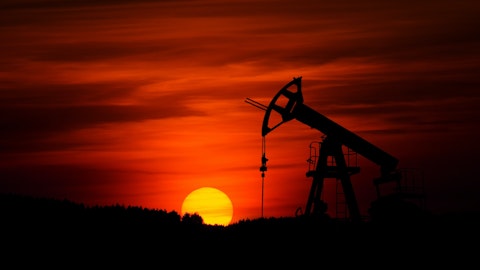Michael Kennedy: No, we were wide in Q3 because of the maintenance on Cove Point, Tennessee pipe. So we sold about 15% to TCO, and that was wide in the third quarter. It’s always weak in the third and fourth quarters during the shoulder months going in the winter. That has improved quite a bit in Q4 those maintenance capital events have subsided. So we’ll sell a lot more in the Gulf Coast. And then when you look at the Gulf Coast going into the winter, those are actually at premium prices to Henry Hub, like Justin mentioned on his slide that interesting slide around the Tier 1 levels and goes right into the LNG corridor where there’s a lot of demand for the gas. We also have quite a bit going to Chicago during the winter, which may be up to $0.50 ahead of Henry Hub right now, and we’re bringing seven wells on in the Utica just in time to enjoy the Chicago gas prices filling our ex capacity.
So I see realizations improving quite a bit in the fourth quarter and heading into 2024.
Roger Read: All right. Thank you. I’ll leave it there.
Operator: The next question is from David Deckelbaum of Cowen. Please proceed with your question.
David Deckelbaum: Thanks for getting me on the call guys. Appreciate the time. Mike, you threw out some exciting numbers, I think, for the next year. The 650, I guess, true maintenance versus maybe an 800 to stay at that 3.5% level or so. Can you just talk about the variables that are influencing that decision? And I guess, as I think about it, is there a breakeven price? Is it $4 gas that would incentivize you to stay at a higher level. Are you being influenced by perhaps like some of the revolver balance that you have right now and wanting to accelerate max free cash in the beginning of the year. I guess, what would be the primary factors that you consider between those two variables?
Michael Kennedy: Yes, the 650 to 700 was what it would have been required to hold that 3.2 Bcfe a day flat. Total 3.35 to 3.4 would have been $100 million or so higher. As I mentioned, the rule of thumb is every $100 million a day of capital is $100 million a day of production. So higher than that to hold the 3.35, 3.4, but well below that 10%. It’s kind of how we think about it. It’s going to be somewhat commodity price dependent, David. We’re obviously heavily influenced by generating free cash flow and paying down all our debt and returning capital to shareholders. So that’s ultimately the number one filter we use. We also want to be extremely capital efficient. So we do have kind of a two and a half rigs signed up for next year.
So that’s kind of the men case. And then we kind of have a floating, we have one completion crew and then a floating completion crew. So that’s kind of how we manage capital. So we have the flexibility to do whichever program we choose or a variation in between. And that’s something we’ll have to consider as we go through this budgeting process and watch commodity prices over the next couple of months.
David Deckelbaum: It doesn’t sound like as you think about like a multi-year progression, are you inherently more operationally efficient with sort of that three rig and two crew program?
Michael Kennedy: Yes, we’re much more efficient that. And when you think about that, we have the drilling JV, so we really only have 85% of that. And this year’s really a three rig program and a one and a half completion crew. Next year you’re kind of looking at a two and a half rig and a one and a half completion crew, again, only having 85% and we can set that down the following year when the drilling JV ends. So we’ve just become remarkably efficient just with our continuous acreage position, having all the infrastructure in place, having all the transport, having all the processing, and then working on our operational efficiencies and having this much success. We’ve just continued to become more and more efficient drill terrific wells,
David Deckelbaum: Would you guys just mind updating us? It’s all very helpful and just the shell cracker progression and some of the assumptions that we should thinking about your ethane volumes for next year?



